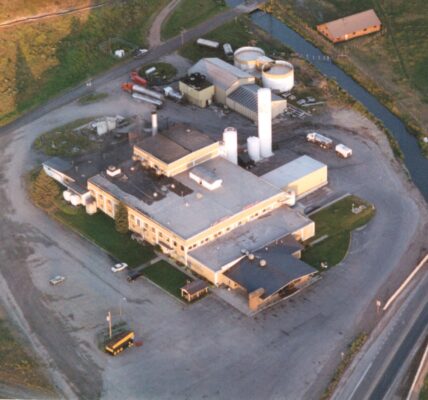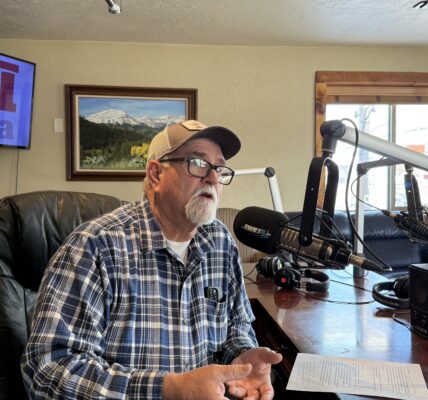Despite staggering costs and logistic challenges, carbon capture studies at Wyoming coal plants advance
By Dustin Bleizeffer, WyoFile.com
Rocky Mountain Power and Black Hills Energy already tap Wyoming ratepayers to pay for state-mandated studies, and will look to government subsidies to defray costs.
Two electric utility companies in Wyoming will advance engineering studies and analysis to potentially retrofit four coal-burning units with carbon capture technology, but significant costs and logistic challenges remain, recent filings with the state show.
That means the utilities’ Wyoming ratepayers, who are now collectively paying more than $3 million annually for the initial phases of study, will soon be paying $10 million to $20 million with no guarantee that a single coal plant might ultimately be retrofitted with the technology.
Rocky Mountain Power and Black Hills Energy detailed to utility regulators last week how they are complying with a suite of state mandates that require them to either install carbon capture to extend the operational life of coal plants or prove it would be uneconomic or technically infeasible to do so.
Rocky Mountain Power, the state’s largest electric utility, provided little new information regarding cost estimates that, a year ago, indicated a price tag of nearly $1 billion per coal unit to install the technology. Black Hills Energy, however, reported that the cost estimate for retrofitting the Wygen II power plant east of Gillette has changed little since last year — between $500 million to $668 million. The company also noted that the cost to build the plant in 2008 was $182.5 million (the equivalent to $268 million in today’s dollars).
Although final determinations about whether to move forward with such retrofits are years away, both utilities say they’re advancing to the next, more expensive phases of engineering studies amid a long list of significant technical and cost challenges.
Black Hills Energy, for example, estimates the next phase of study at the Wygen II plant will cost between $8 million to $10 million over the next 12 to 15 months — a significant increase compared to the $1.1 million for the first phase of study. Both utilities are tapping their ratepayers for the cost of the studies. However, both have said they will seek private investment and government subsidies — including from Wyoming — to help defray future costs to their customers.
That’s already the case for one of three potential carbon capture retrofits for Rocky Mountain Power. The utility announced last week a partnership with North Carolina-based 8 Rivers and South Korea’s SK Group to potentially apply an “oxyfuel” carbon capture process at either the Dave Johnston coal-fired power plant near Glenrock or the Wyodak plant outside Gillette. Rather than tap ratepayers, 8 Rivers will cover the cost of that study, according to Rocky Mountain Power.

Despite not ruling out the potential for carbon capture retrofits, both utilities detailed many technical, logistical and environmental challenges, in addition to hefty price tags, if a retrofit project were to move forward to construction.
Although Wyoming lawmakers — and Gov. Mark Gordon — hope that federal tax credits and the opportunity to sell captured carbon dioxide for enhanced oil recovery will help bring down cost estimates, the utilities’ new filings don’t seem to indicate an economically justified path forward, said Shannon Anderson, who has tracked the effort for years.
“It’s just fascinating because [the cost of] carbon capture retrofits are still so much higher than renewable energy — even solar with storage and other options,” said Anderson, an attorney for the Sheridan-based landowner advocacy group Powder River Basin Resource Council.
Gordon, however, hailed Rocky Mountain Power’s tentative plan to retrofit two units at the Jim Bridger coal-fired power plant with carbon capture as a “remarkable change of direction.” Jim Bridger, which operates east of Rock Springs, was the largest coal-fired plant in the West.
“Just a few years ago, the Integrated Resource Plans being submitted to the Wyoming Public Service Commission were all targeted towards the elimination of coal-fired power plants,” Gordon said Tuesday in a prepared statement.
He credited himself and the Wyoming Legislature with providing “additional options” for keeping coal plants in operation by passing several laws that mandate carbon capture retrofits.
“Granted the [integrated resource plans] are plans and do change,” Gordon continued, “but to select carbon capture as the preferred portfolio for Jim Bridger Power Plant units 3 and 4 is an accurate reflection of the need to be able to produce 24-hour dispatchable power. It is a remarkable change of direction, which — if shown to be economically beneficial — will be a win for Wyoming, our consumers and the consumers served by PacifiCorp [Rocky Mountain Power’s parent company].”
Black Hills Energy
Black Hills Energy initially launched engineering feasibility studies for two coal plants in the state: the Neil Simpson II plant owned by subsidiary Black Hills Power and Wygen II owned by subsidiary Cheyenne Light, Fuel and Power.
The Wyoming Public Service Commission, however, recently granted permission to remove the Neil Simpson II plant from the mandated studies due to a law passed in March that exempts utilities with fewer than 10,000 customers. Black Hills Power has a customer base of about 2,600 in northeast Wyoming.
That leaves Cheyenne Light, Fuel and Power’s Wygen II coal plant, where the utility is working with engineering firm Black & Veatch and others on “novel” approaches to apply carbon capture technology. But there are many logistic, technical and environmental challenges — not the least of which is an estimated 40% to 65% reduction in power generation output due to the parasitic load of powering a carbon capture facility, according to the company.
If retrofitted with the technology, even semi-annual routine maintenance may require taking the power plant offline temporarily, Black Hills Power reported. In other words, the plant would provide less power with potentially less consistency, which would violate other aspects of Wyoming laws passed in recent years to ensure reliable coal-based power.
There are other challenges.
The most promising carbon capture technology to adapt to Wygen II, according to the utility, would take up a lot of space — about 6.4 acres, “which will consume all the space currently available near Wygen II.” The power plant is one of five located at the Wyodak complex just east of Gillette, squeezed between Highway 51 to the south and Interstate 90 to the north.
Given space limitations, critical connections such as water and high-pressure steam pipelines “will have to be routed over two roadways,” the utility said. “If this facility is built, it will eliminate the potential of any future growth adjacent to the existing plants or the ability for other units at the [Wyodak complex] to also utilize any type of carbon capture technology.”
There’s also new environmental considerations that come with the technology that will require additional permitting, and the plant’s location offers limited access to water, according to the company.
“The operation of the [carbon capture, use and storage] technology could emit air pollutants other than CO2 that may have an impact on ambient air quality in the area,” the company said. “The [carbon capture, use and storage] addition will generate wastewater and solid waste that will require hauling off site or require a significant amount of water usage that would apply stress on existing aquifers in the area.”
Capturing the planet-warming greenhouse gas at Wygen II could also triple the coal unit’s “heat rate” — an increase that would render the plant uneconomic, according to Black Hills Energy.
Rocky Mountain Power
The Rocky Mountain Power, 8 Rivers and SK Group collaboration focuses on a gasification technology that uses captured carbon dioxide to drive a power-generating turbine to help offset power loss typically associated with retrofitting existing coal-fired power plants, according to a company press release last week.
The utility described the technology as “competitively viable” and potentially suited for either the Wyodak coal plant near Gillette or unit 4 at the Dave Johnston plant at Glenrock.
Meantime, Rocky Mountain Power continues to work with a consortium of engineering firms led by Enchant Energy to study the feasibility of capturing carbon dioxide at two of four coal-burning units at the Jim Bridger power plant — units 3 and 4. Jim Bridger units 1 and 2 were taken offline in December and are now being converted to natural gas.
Although Rocky Mountain Power’s update to the state was vague regarding estimated costs, the two Jim Bridger units under consideration are large — each with a generating capacity range of about 600 to 700 megawatts compared to Wygen II at 95 megawatts. It’s unclear how much it might cost to retrofit the coal units or how much the utility might charge its Wyoming customers for the cost of studying them for carbon capture suitability.
So far, Rocky Mountain Power is collecting an annual $2 million to cover engineering feasibility costs. Although the utility still considers the units potentially suitable for carbon capture, it listed several challenges, including the fact that carbon capture has never been successfully applied to such large coal-fired power plants, according to the company’s filing.
Power generation capacity loss remains a concern, as does the potential need to access more water. The utility is also contemplating a carbon capture scenario that might require shipping coal from the Powder River Basin in northeast Wyoming — a significant cost increase over accessing coal from the nearby Bridger coal mine, the company said.
Previously, Rocky Mountain Power’s long-range planning called for converting Jim Bridger units 3 and 4 to natural gas in 2030 and retiring the units in 2037. The company noted in its filings with the state that it is considering a carbon capture retrofit prior to 2030 and fully retiring the units in 2039 — extending the operational life of the units by only two years in comparison.
Government subsidies
Both Black Hills Energy and Rocky Mountain Power are factoring the potential to earn federal 45Q tax credits, which could provide up to $85 per ton of carbon dioxide. Senate File 42 – Low-carbon reliable energy standards-amendments, which was signed into law in March, also clarifies that utilities subject to the state’s mandate must consider revenue and credits earned from injecting the greenhouse gas into oil fields to produce more oil — even though that’s likely a business separate from the utility.
Both utilities also indicated they may seek cash subsidies from Wyoming’s energy matching funds programs to leverage private and federal dollars to help fund the efforts.





